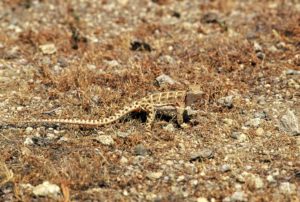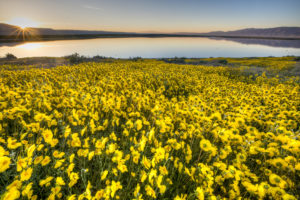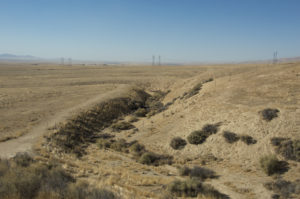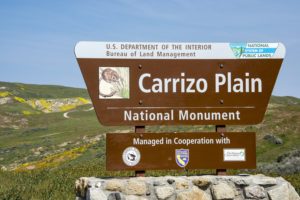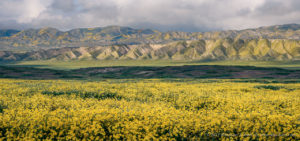About the Carrizo Plain National Monument
Home to the pronghorn antelope, North America’s fastest animal on land. California condors soar overhead. San Joaquin kit foxes, giant kangaroo rats, and blunt-nosed leopard lizards burrow underground, seeking refuge from the harsh elements. Not to mention dazzling fields of wildflowers, Native American rock art, a giant alkali lake, and the oldest section of the San Andreas fault.

Pronghorn on the Carrizo Plain National Monument during the 2017 Superbloom. Photo by Patti Gutshall.
These all converge on the Carrizo Plain, a vast expanse of golden grasslands and stark ridges adjacent to the Los Padres National Forest near the southeastern tip of San Luis Obispo County. Often referred to as “California’s Serengeti,” it is one of the last undeveloped remnants of the southern San Joaquin Valley ecosystem. The Carrizo Plain is critical for the long-term conservation of this dwindling ecosystem, linking these lands to other high-value habitat areas like the Los Padres National Forest, the Salinas Valley, the Cuyama Valley, and the Bitter Creek National Wildlife Refuge in western Kern County.
Honoring the area’s high biodiversity, limited human impacts, and rare geological and cultural features, the Carrizo Plain was declared a National Monument in 2001, and now includes more than 206,000 acres of public lands – perhaps the largest native grassland remaining in all of California.
Two distinct mountain ranges rise above the plain — the Calientes and the Temblors. At 5,106 feet in elevation, Caliente Mountain is the highest point in San Luis Obispo County. The San Andreas Fault creates dramatic changes in the landscape at the eastern edge of the Carrizo Plain. Soda Lake, a seasonal body of water, is the centerpiece of the plain. In the heart of the Carrizo Plain, a sacred Chumash ceremonial site rises 55 feet from the valley floor. Trails, camp sites, seasonal wildflower tours, and ample bird-watching opportunities abound. These unique features and relatively pristine condition make the Carrizo one of our region’s most unique areas and one highly deserving of protection.
>>View a map of the Carrizo Plain National Monument
Wildlife & Wildflowers
The Carrizo Plain is home to one of the largest concentrations of rare plants and animals in all of California and is vital to their survival. It is one of the last refuges for the San Joaquin kit fox, San Joaquin antelope squirrel, burrowing owl, giant kangaroo rat, and blunt-nosed leopard lizard. The Carrizo Plain is also prime habitat for pronghorn antelope and Tule elk, which were once found throughout the deserts and grasslands of Southern California. The Carrizo Plain also supports golden eagles and other raptors, and provides winter refuge for migrating birds, such as American white pelicans, sandhill cranes, and many species of swans and ducks.
Along with this amazing wildlife diversity, the Carrizo Plain hosts a diversity of plant communities, including iodine bush, salt bush scrub, valley grasslands, and California Juniper woodland. Rare plants like the California jewelflower, Hoover’s wooly-star, Munz’s tidy tips, and pale-yellow layia are found amidst prolific wildflower blooms each spring, transforming entire hillsides into vibrant palates of yellow, purple, and orange.
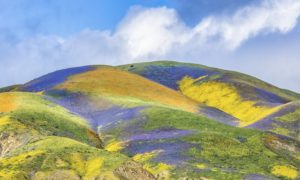
The 2017 Superbloom resulted in dazzling displays of wildflowers throughout the national monument, including in the Temblor Range. Photo by Ronald L. Williams.
Soda Lake
The 3,000-acre Soda Lake is one of the plain’s most distinguishing features. The lake has no natural outfall, and when the water evaporates, it leaves behind a glistening expanse of minerals that support a unique community of rare plants and animals. Shorebirds, including thousands of sandhill cranes, as well as fairy and brine shrimp, depend on the seasonal, briny water that fills the lake only in the winter. The lake is one of the largest undisturbed alkali wetlands in California. Throughout the Carrizo Plain visitors can also find numerous vernal pools, which support rare plants and animals and spring wildflowers.
The San Andreas Fault
In addition to its large diversity of plants and animals, the Carrizo Plain is also renowned for its amazing geology, which is in no small part shaped by the San Andreas Fault. The fault traverses the eastern side of the Carrizo Plain, along the base of the Temblor Range, altering the course of some streams, most notably Wallace Creek, and creating “sag ponds,” which trap rainwater and create habitat for endemic species. The section of the fault through the Carrizo Plain is recognized as the most spectacular along the fault’s 800-mile stretch.
Cultural heritage
The Chumash, Yokuts, Salinians, and other native peoples made extensive use of the Carrizo Plain, and left their mark in the many notable cultural remnants. Native tribes hunted game and traded amongst one another in the Carrizo Plain, and the history of these uses is reflected in cultural sites such as Painted Rock, which continues to be used for ceremonial purposes.
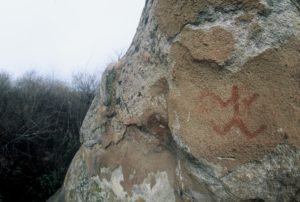
The Carrizo Plain is home to many culturally- and spiritually-important sites for Native American tribes such as the Chumash. Ancient rock art can be found at protected sites throughout the national monument. Photo by Chuck Graham.
Designation as a National Monument
In 2001, the Carrizo Plain National Monument was established by Presidential Proclamation “so that indigenous species interact within a dynamic and fully functioning system in perpetuity while conserving unique natural and cultural resources and maintaining opportunities for compatible scientific research, cultural, social and recreational activities.” Today, the Carrizo Plain is managed cooperatively by the BLM, the California Department of Fish and Game, and The Nature Conservancy.
Designation as a National Historic Landmark
In 2012, the Department of the Interior announced the designation of 13 new National Historic Landmarks in nine different states, including the unique concentration of archeological sites, art, and artifacts of California’s own Carrizo Plain National Monument. Carrizo’s outstanding sites have been recognized for almost a century by anthropologists, archeologists, artists, and novelists, and are regularly enjoyed by ForestWatch volunteers after a day of hard work tearing down relic barb wire fencing on the plain. The Carrizo’s pictographs, villages and camps (a collection of over 100 sites,) that are being listed as National Historic Landmarks, document some of the history of the first inhabitants of the western United States.
Current Threats
Even though much of the Carrizo Plain is now a National Monument, the area continues to face significant development pressures. During the establishment of the National Monument, oil companies were able to retain underground mineral rights within the monument boundaries. In 2008, one of these companies – Vintage Production (a subsidiary of oil giant Occidental Petroleum) – announced plans to conduct oil exploration activities in the heart of the Carrizo Plain using 60,000-lb “thumper trucks” and dynamite. Such exploration techniques would spell disaster for these lands and the imperiled wildlife found here, particularly for ground-dwelling animals like the endangered San Joaquin kit fox. Moreover, Vintage had previously caused the disastrous 2007 oil spill in the Sespe Condor Sanctuary along with a dozen other spills in the area. After a strong community response and serious consideration of the environmental consequences, the BLM ordered the company to undertake a comprehensive environmental impact study. ForestWatch worked alongside a coalition of conservation organizations in demanding this study.
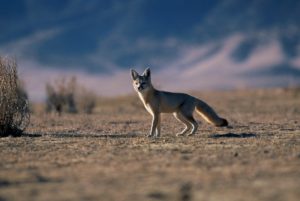
The Carrizo Plain is one of the last remaining areas supporting the endangered San Joaquin kit fox. Photo by Chuck Graham.
This isn’t the first time that Big Oil has tried to encroach on the Carrizo. In 2005, the holder of the last remaining undeveloped oil lease in the monument declared his intention to drill for oil. Because of our efforts, his lease expired before drilling took place, and the area known as Wells Canyon is safe for now. In 2007, ForestWatch also halted a proposal to lease several thousand acres of land along the monument boundary to oil companies. We will continue to ensure that oil development does not invade the quiet solitude of the Carrizo Plain.
A New Vision for the Carrizo
When the Carrizo Plain National Monument was established in 2001, the federal agency that manages the area — the Bureau of Land Management — began work on a management plan for the area. After a rocky start fraught with delays, the planning process resumed in 2007. ForestWatch teamed up with a coalition of conservation organizations — The Wilderness Society, Santa Lucia Chapter of Sierra Club, Center for Biological Diversity, Natural Resources Defense Council, California Wilderness Coalition, Defenders of Wildlife, Californians for Western Wilderness, and Western Watersheds — to outline our vision for the monument.
After years of public input periods, hearings, and stakeholder meetings, the BLM finally released the Carrizo Plain National Monument Resource Management Plan in 2010. The document contains detailed information about what is allowed on the national monument and how the area will be managed. It is one of the most robust resource management plans in the country, and the national monument’s stakeholders have overwhelmingly supported its provisions. Unfortunately, the 2017 review of national monuments directed by President Trump has taken aim at all management plans for national monuments. Despite a lengthy development process and incorporation of public input, the Carrizo Plain’s management plan may soon be changed by the Trump administration to allow for environmentally-destructive activities to take place on the national monument. ForestWatch will continue to fight for the responsible management of the Carrizo Plain National Monument and all of the critically-important wildlife and wild places found there.

